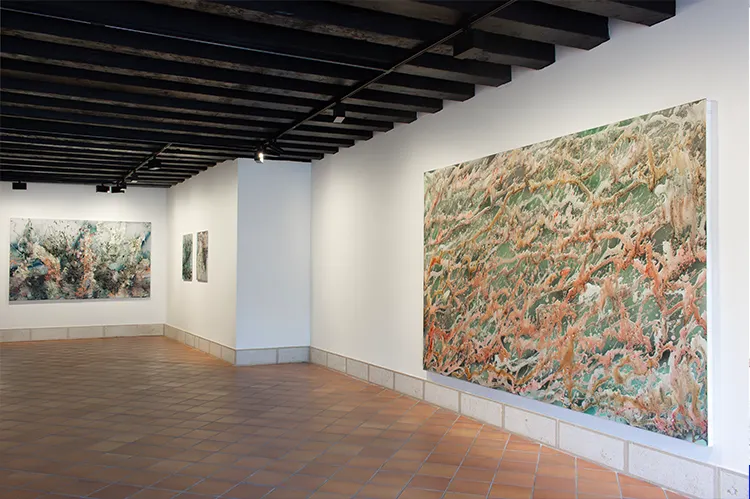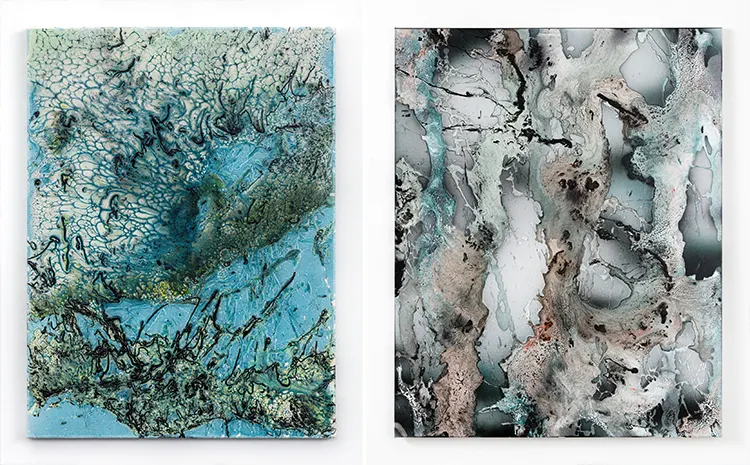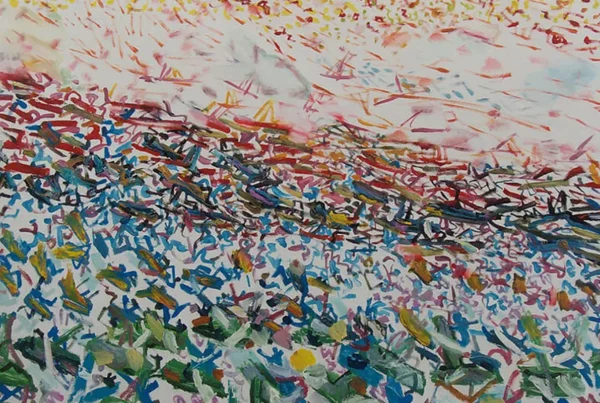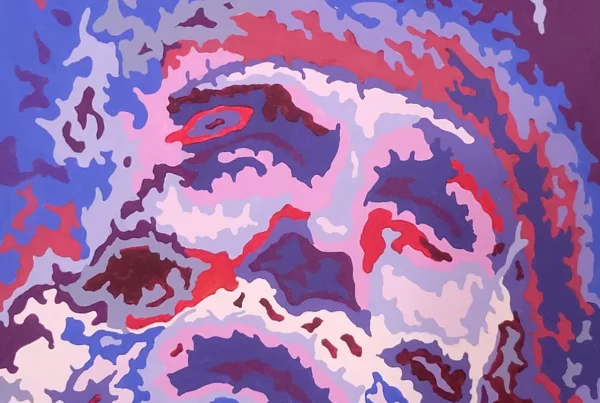“In their elusive fluidity, the canvases insinuate motion, an eternal becoming, never pausing but always advancing — a metaphorical image of Venice herself.”
Márta Kucsora: A Dance of Fluid Modernity in Venice
Venice, a city built on water, provides a poetic backdrop for Márta Kucsora’s latest exhibition. With its shimmering canals, ever-shifting tides, and labyrinthine streets, the setting feels like an extension of the artist’s practice—a celebration of the fluid, interconnected, and ephemeral nature of existence. The exhibition, housed within the historic walls of Patricia Low Contemporary, Venezia, invites viewers to delve into a universe where paint flows like the lagoon waters, embodying both the beauty and volatility of nature.
The opening of Less Orderly Ways coincided with the final weekend of La Biennale, 2024, making Venice even more alive with artistic fervor. I stumbled upon this exhibition quite by accident while wandering along the Grand Canal on a chilly afternoon, just across from Palazzo Grassi. Having just visited Palazzo Grassi to see Julie Mehretu’s extraordinary show, Ensemble—the largest exhibition of her work to date in Europe—I was already immersed in the visual language of abstraction and fluidity. Drawn into Patricia Low Contemporary by the vibrant hues radiating from within, I felt an immediate resonance with the space and its offerings.

Liquid Ecologies in Motion
The moment I stepped inside, my eyes were captured by a stunning 2-by-3-meter pink painting, Unlike an Activated Stage, which hung on the left wall. Its commanding presence and intricate textures pulled me into Kucsora’s liquid world. Further in, I found myself deeply moved by the bright yellow large diptych, Serendipity Comes About in Strange Ways, which radiated an infectious energy, encapsulating both spontaneity and intent.
Márta Kucsora’s works are an alchemical exploration of fluid dynamics and the psychological depths of color and texture. Each large-scale canvas pulsates with energy, presenting what the artist calls “liquid ecologies.” These are immersive worlds where natural forces and the artist’s intuition converge, creating compositions that oscillate between chaos and harmony. The interplay of layered pigments, biomorphic shapes, and calligraphic drips evokes Venice’s own intricate balance between human ingenuity and the capricious forces of water.

Márta Kucsora: Echoes of Liquid Modernity in Art
One cannot overlook the resonance of Zygmunt Bauman’s concept of “liquid modernity” in this body of work. Much like Venice itself—a city perpetually adapting to rising tides and cultural flux—Márta Kucsora’s paintings reflect a world in constant transformation. The thin, fiery layers of paint and gestural lines mimic the transience of modern life, where boundaries blur, and identities shift like reflections on a canal.
In this exhibition, the paintings serve as both aesthetic marvels and philosophical inquiries. The use of bright, saturated colors—applied with a spray gun and layered with a translucent gel—creates an illusory depth that draws viewers into a dreamlike dimension. Tilting the canvas during the creative process generates lava-like formations, reminiscent of the organic, surreal beauty of Venice’s lagoon at sunrise or its algae-laden waters after a storm. The calligraphic lines, dripping and splashing across the surface, echo the city’s interwoven waterways, steering the viewer’s gaze through an intricate visual narrative.
The artist’s studio, described as a space akin to an operating room, highlights the urgency and precision required to work with volatile materials. This controlled chaos mirrors the delicate dance of Venetian life, where the balance between preservation and innovation is constantly negotiated. The result is a body of work that feels alive, its viscous textures and radiant hues capturing the essence of transformation and temporality.

A Triumph of Fluid Aesthetics
Venice’s unique relationship with water deepens the exhibition’s impact. The city’s reflections and refractions seem to extend the paintings beyond the gallery walls, dissolving the boundaries between art and environment. Standing before these compositions, one is reminded of the fluid interconnectedness of all things—a theme that resonates with the city’s maritime history and its precarious future in the face of rising seas.
Márta Kucsora invites us to engage with the incomplete temporality of consciousness and the sequentiality of subjective experience. Like Venice itself, the paintings demand to be navigated slowly, with attention to subtle differences and the meditative rhythm of interlocking frames. They are time capsules, encapsulating the artist’s psyche while simultaneously offering a mirror to our own.
This exhibition, Less Orderly Ways, is a triumph of synthesis: between material and metaphor, control and spontaneity, and art and environment. Márta Kucsora has not only captured the spirit of Venice but also created a body of work that transcends its physical confines, leaving viewers with a sense of awe and a deeper appreciation for the fluidity of existence.






